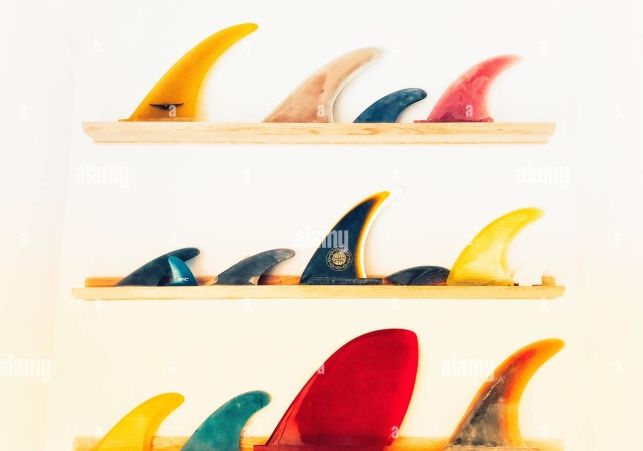Different types of surfboard fins and their effects

Surfboard fins are essential components of any surfboard, playing a crucial role in controlling the board's maneuverability, stability, and speed. From the classic single fin to the more modern quad setups, each type of fin configuration offers unique characteristics that cater to different surfing styles, wave conditions, and skill levels. In this comprehensive guide, we'll delve into the various types of surfboard fins, exploring their designs, functions, and effects on surfing performance.
-
Single Fin: The single fin setup is one of the oldest and simplest configurations, consisting of a single large fin mounted at the tail's center. Historically, this setup dominated the surfing scene before the advent of multi-fin setups. Single fins offer stability and control, making them ideal for long, drawn-out turns and smooth, graceful surfing. They excel in larger, more powerful waves where speed and control are paramount. However, single fins can feel somewhat restrictive compared to multi-fin setups, limiting maneuverability and responsiveness in smaller, more playful waves.
-
Twin Fin: Twin fin setups feature two smaller fins positioned symmetrically on either side of the tail. This configuration provides a looser, more playful feel compared to single fins, allowing for quicker turns and tighter maneuvers. Twin fins are popular among surfers seeking a more skatey, high-performance ride, particularly in small to medium-sized waves with clean faces. They offer increased maneuverability and speed down the line, making them suitable for progressive, aerial-oriented surfing styles. However, twin fins may lack the stability and control of larger fin setups, particularly in larger, more challenging surf conditions.
-
Thruster (Tri-fin): The thruster setup revolutionized surfing in the 1980s, introducing a dynamic blend of speed, control, and maneuverability. Consisting of three fins—two smaller side fins and a larger center fin—arranged in a triangular formation, the thruster configuration offers a versatile balance of stability and responsiveness. Thrusters excel in a wide range of wave conditions, from small, mushy waves to powerful, hollow barrels. The center fin provides drive and control while the side fins enhance maneuverability and hold through turns. Thrusters are the go-to choice for most surfers due to their adaptability and performance across various wave types and surfing styles.
-
Quad Fin: Quad fin setups feature four fins—two on each side of the tail—positioned closer to the rails than the centerline. Quad fins offer a unique blend of speed, drive, and maneuverability, making them well-suited for fast, down-the-line surfing and generating speed in smaller, weaker waves. The absence of a center fin reduces drag, allowing for increased speed and fluid rail-to-rail transitions. Quad setups excel in fast, hollow waves where speed and responsiveness are crucial for navigating critical sections and executing high-performance maneuvers. However, they may feel less stable and controlled than thrusters in larger, more powerful surf conditions.
-
5-Fin (Quad + Trailer): The 5-fin setup combines the versatility of thrusters with the speed and drive of quad fins, offering surfers the option to switch between different configurations to suit changing wave conditions and personal preferences. This setup typically includes a thruster configuration (three fins) with the option to add two extra quad fins, known as trailers, to the rear plugs. Surfboards equipped with a 5-fin setup provide unparalleled versatility, allowing surfers to fine-tune their board's performance by adjusting the number and arrangement of fins according to wave size, shape, and riding style.
-
Bonzer: The Bonzer fin setup features a combination of a single center fin and multiple smaller side fins arranged in a unique, concave configuration. Developed in the 1970s by the Campbell brothers, the Bonzer setup offers exceptional speed, drive, and hold through turns. The deep concaves between the side fins channel water flow, creating lift and reducing drag, while the center fin provides stability and control. Bonzer setups excel in fast, powerful waves, allowing surfers to generate speed and maintain control in critical sections. They offer a distinct feel and ride experience, ideal for experienced surfers seeking a high-performance edge in challenging conditions.
In summary, surfboard fins come in various shapes, sizes, and configurations, each offering a distinct combination of speed, control, maneuverability, and stability. Whether you're a beginner learning the basics or an experienced surfer pushing the limits of performance, choosing the right fin setup can significantly impact your surfing experience. Experimenting with different fin configurations allows surfers to fine-tune their boards to match their riding style, wave conditions, and skill level, unlocking new levels of performance and enjoyment in the water.
